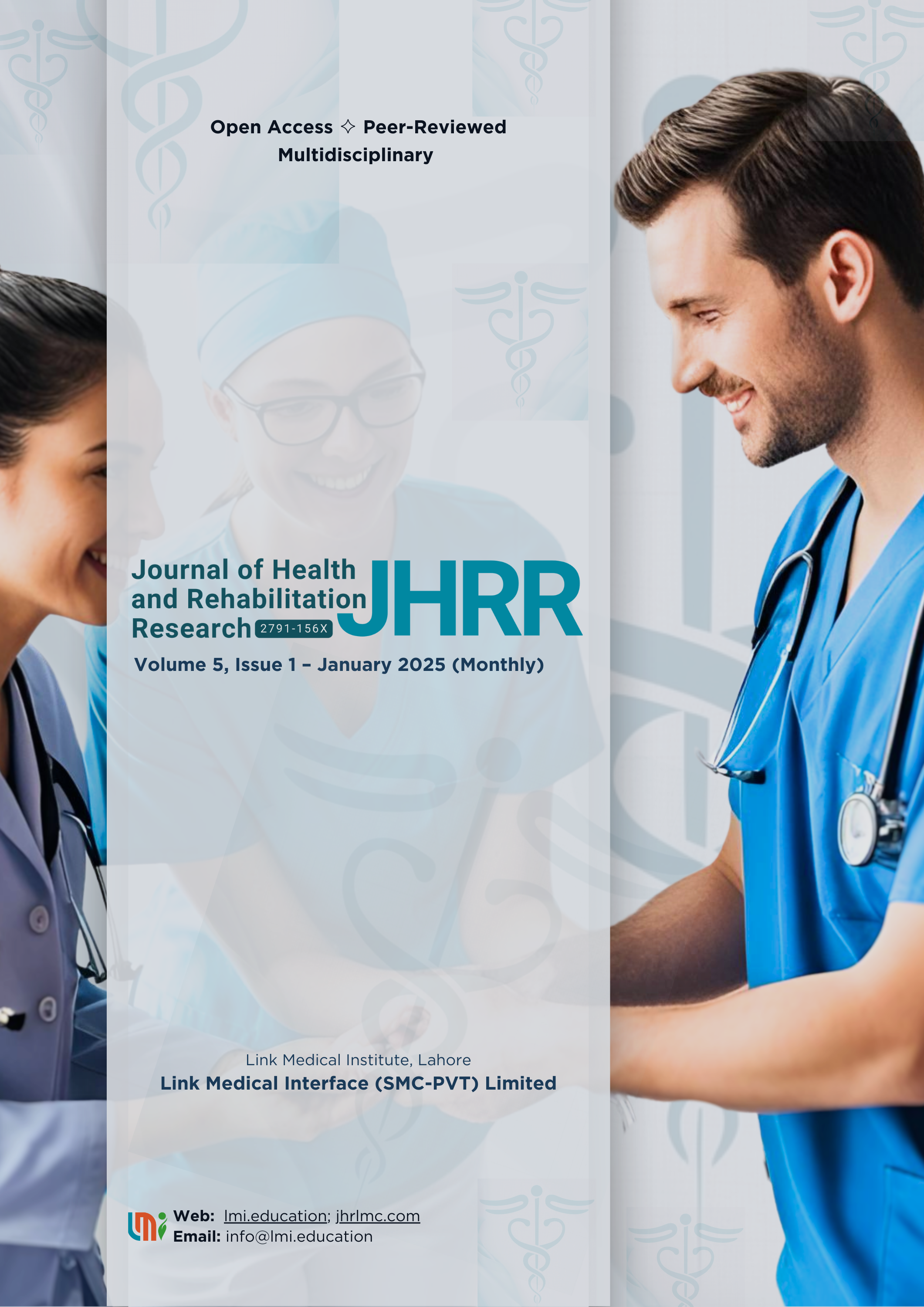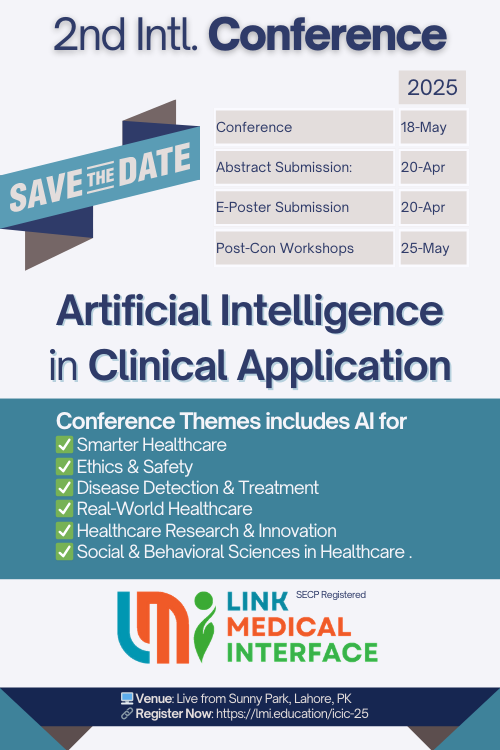The Role of Technology in Speech-Language Therapy: Perceptions, Effectiveness, and Challenges in a Resource-Limited Setting
DOI:
https://doi.org/10.61919/jhrr.v5i1.1754Keywords:
Speech-Language Pathology, Telemedicine, Artificial Intelligence, Mobile Applications, Digital Health, Technology AdoptionAbstract
Background: The integration of technology in speech-language therapy has expanded globally, offering new approaches such as mobile applications, teletherapy platforms, and artificial intelligence (AI)-based tools. However, in resource-limited settings like Pakistan, adoption remains inconsistent due to infrastructural, financial, and training constraints. Objective: To assess the perceptions, effectiveness, and challenges of using technology in speech-language therapy among speech-language pathologists (SLPs), clients, and researchers at Chughtai Medical Center, Lahore, Pakistan. Methods: A cross-sectional survey was conducted over six weeks using an online questionnaire distributed to 178 participants. The survey assessed demographics, technology usage, perceived effectiveness (Likert scale 1–5), barriers, and future perspectives. Quantitative data were analyzed using IBM SPSS Statistics 25, applying descriptive statistics, chi-square tests, and t-tests to determine associations (p < 0.05 considered significant). Results: Technology usage was reported by 50% (n = 89) of participants, with 40% (n = 71) using mobile apps, 30% (n = 53) using teletherapy, and 10% (n = 17) utilizing AI tools. Perceived effectiveness for language development was rated 3.5/5, client engagement 3.2/5, and teletherapy 3.0/5. Major barriers included technical issues (60%, n = 107), lack of training (50%, n = 89), and cost (40%, n = 71). AI effectiveness was significantly lower than traditional technology (p < 0.0001). Conclusion: Despite moderate effectiveness, technology adoption in speech-language therapy is limited by infrastructural and financial challenges. Policy-driven solutions, training programs, and improved accessibility are essential for optimizing digital interventions.
Downloads
References
Hye-Ji Suh, et al. Opportunities and Challenges for AI-Based Support for Speech-Language Pathologists. Symposium on Human-Computer Interaction for Work. 2024.
Juliane Leinweber, et al. Technology Use in Speech and Language Therapy: Digital Participation Succeeds Through Acceptance and Use of Technology. Frontiers in Communication. 2023.
Nathan V. Mallipeddi, et al. Telepractice in the Treatment of Speech and Voice Disorders: What Could the Future Look Like? Perspectives of the ASHA Special Interest Groups. 2023.
Ankur Bhardwaj, et al. Transforming Pediatric Speech and Language Disorder Diagnosis and Therapy: The Evolving Role of Artificial Intelligence. Health Sciences Review. 2024.
Soheila Saeedi, et al. The Willingness and Attitudes of Speech-Language Pathologists Towards the Use of Mobile Health Technology: A Survey Study. BMC Health Services Research. 2023.
S. B. Evangeline, et al. Investigating AI Applications in Communication Tools for Individuals With Speech Impairments: An In-Depth Analysis. 2024 IEEE International Conference on Interdisciplinary Approaches in Technology and Management for Social Innovation (IATMSI). 2024.
Kamaruddin, et al. The Knowledge and Use of Speech Therapy Mobile Applications: Speech-Language Pathologists’ Perspectives in Malaysia. International Journal of Integrated Engineering. 2023.
Shirley Gherson, et al. Rapid Implementation of Teletherapy for Voice Disorders: Challenges and Opportunities for Speech-Language Pathologists. Journal of Voice. 2023.
Yao Du, et al. "They Can't Believe They're a Tiger": Insights From Pediatric Speech-Language Pathologists Mobile App Users and App Designers. International Journal of Language and Communication Disorders. 2023.
G. Georgieva-Tsaneva, et al. Exploring the Potential of Social Robots for Speech and Language Therapy: A Review and Analysis of Interactive Scenarios. Machines. 2023.
Agnetha Gallant, et al. Experiences of South African Speech-Language Therapists Providing Telepractice During the COVID-19 Pandemic: A Qualitative Survey. International Journal of Language and Communication Disorders. 2023.
K. Hilari, et al. Telehealth Practice in Aphasia: A Survey of UK Speech and Language Therapists, With a Focus on Assessment. International Journal of Language and Communication Disorders. 2023.
Dancheng Liu, et al. Automatic Screening for Children with Speech Disorder Using Automatic Speech Recognition: Opportunities and Challenges. Proceedings of the AAAI Symposium Series. 2024.
Catherine Diaz-Asper, et al. A Framework for Language Technologies in Behavioral Research and Clinical Applications: Ethical Challenges, Implications, and Solutions. American Psychologist. 2024.
Fatemeh Hassanati, et al. Face-To-Face and Telespeech Therapy Services for Children During the COVID-19 Pandemic: A Scoping Review. Iranian Journal of Child Neurology. 2023.
Adikari, et al. From Concept to Practice: A Scoping Review of the Application of AI to Aphasia Diagnosis and Management. Disability and Rehabilitation. 2023.
Downloads
Published
How to Cite
Issue
Section
License
Copyright (c) 2025 Quratul Ain, Rabia Imtiaz

This work is licensed under a Creative Commons Attribution 4.0 International License.
Public Licensing Terms
This work is licensed under the Creative Commons Attribution 4.0 International License (CC BY 4.0). Under this license:
- You are free to share (copy and redistribute the material in any medium or format) and adapt (remix, transform, and build upon the material) for any purpose, including commercial use.
- Attribution must be given to the original author(s) and source in a manner that is reasonable and does not imply endorsement.
- No additional restrictions may be applied that conflict with the terms of this license.
For more details, visit: https://creativecommons.org/licenses/by/4.0/.






